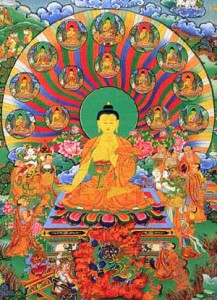The following is an excerpt from a teaching by Jetsunma Ahkon Lhamo called “Conceptual Proliferation”
The Buddha approaches it at the level of understanding our true nature. The Buddha teaches us that our nature is the pristine primordial wisdom nature, which is free of any contrivance and free of any discrimination or delusion; that that nature is spacious and innately wakeful and free of any kind of limitation. The Buddha teaches us that we are also samsaric beings, which means that while we have that nature, we somehow throughout time have arrived at the acceptance of the idea of self-nature as being inherently real. Now the nature that the Buddha talks about is a nature which is free of the contrivance of self. That nature is free of that thought or idea or confinement, I should say. Yet, at the same time, while our nature is free of that contrivance of the idea of self-nature, somehow we have arrived at the false assumption of self-nature, and we have the habit of a continuum experienced as self.
Now in that continuum experienced as self, we have engaged since time out of mind, because the assumption of self-nature didn’t only come at this birth, according to the Buddha’s teaching. It didn’t even come at the previous birth. We have been assuming the identity of self-nature since time out of mind, since literally beginningless time, a time that is untraceable. The Buddha teaches us that we have been born many, many times; that we are continuing on a wheel of death and rebirth, death and rebirth, death and rebirth. That continuum actually continues because of the assumption of self-nature as being inherently real and therefore the desire that arises from that assumption. The Buddha teaches us that we actually continue as we do, wandering in samsara, or cyclic death and rebirth, due to desire based on the assumption of self -nature as being inherently real, because it is the self that desires.
Copyright © Jetsunma Ahkon Lhamo. All rights reserved

